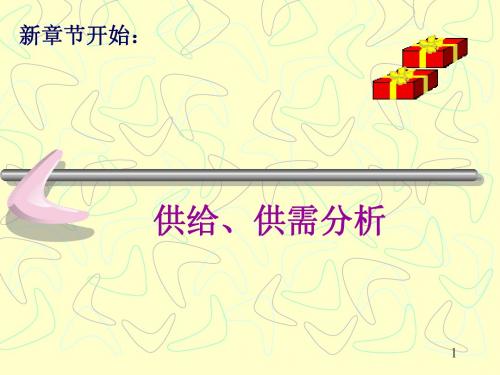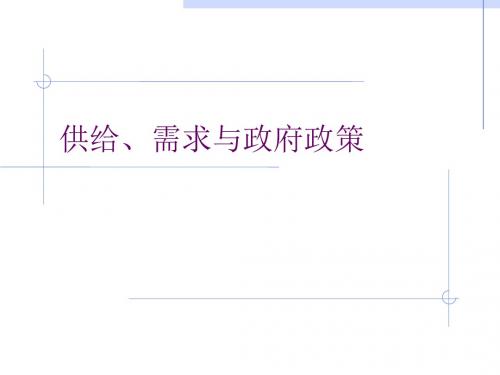4-供给、需求与政府政策
- 格式:pdf
- 大小:900.69 KB
- 文档页数:36

第6章供给、需求与政府政策习题一、名词解释1、价格上限2、价格下限3、短缺4、过剩5、税收归宿二、正误题(请判断下列描述的正误,正确的打√,错误的打×)1、______如果每加仑汽油的均衡价格是1美元,而且,政府把每加仑汽油的价格上限定为1.5美元,结果将是汽油短缺。
2、______低于均衡价格的价格上限将引起过剩。
3、______高与均衡价格的价格下限是一种限制性约束。
4、______与短期相比,限制性租金控制引起的住房短缺在长期中可能更为严重。
5、______最低工资有助于所有青年人,因为他们得到的工资高于没有最低工资时得到的工资。
6、______最低工资增加10%,引起青年人的就业减少10%。
7、______今天没有限制性的价格上限,当未来需求增加,均衡价格上升到高于固定的价格上限时,就会引起短缺。
8、______一个市场的价格下限总会引起该市场上的过剩。
9、______对棒球手套征税10美元总会使棒球手套的买者支付的价格高10美元。
10、______最终的税收负担会主要落在缺乏弹性的市场一方。
11、______如果药品是必需品,对药品征税的负担可能更多地落在药品买者的身上。
12、______当我们用供求模型分析向买者征的税时,我们把需求曲线向上移动税收的大小。
13、______向买者征税和向卖者征同样的税,影响是相同的。
14、______税收在买者和卖者之间打入了一个楔子。
这就引起买者支付的价格上升,而卖者得到的价格下降,以及销售量减少。
15、______政府可以通过向买者征税而不向卖者征税,选择把税收负担加在市场上的买者身上。
16、______一般来说,税收提高了买者支付的价格,降低了卖者得到的价格,并减少了销售量。
17、______如果对一种物品征税,并减少了销售量,税收就必定有无谓损失。
18、______当对一种物品征税时,政府得到的收入正好等于税收引起的消费者剩余和生产者剩余的损失。





供给与需求的影响因素供给与需求是市场经济中两个核心概念,它们相互作用,决定着商品和服务的价格与数量。
然而,供给与需求的变动受到多种因素的影响。
本文将探讨供给与需求的影响因素,并分析其对市场经济的影响。
一、供给的影响因素供给是指生产者愿意在特定价格下提供的商品或服务的数量。
供给的影响因素有以下几个方面。
1. 生产成本生产成本是影响供给的关键因素之一。
生产成本包括原材料成本、劳动力成本、设备成本等。
当生产成本上升时,供给量可能会减少,因为生产者需要投入更多资源来满足同样的生产需求。
2. 生产技术生产技术的进步可以提高生产的效率,降低生产成本。
如果生产技术得到提升,生产者可以以更低的成本提供更多的商品和服务,从而增加供给量。
3. 生产者预期生产者对市场未来的预期也会影响供给。
如果生产者预期未来的市场需求会增加,他们可能会增加生产,以满足未来的市场需求,从而增加供给量。
4. 政府政策政府的政策也会对供给产生影响。
例如,减税政策可以降低生产者的成本,从而提高供给。
另外,对进口商品的限制措施也会影响供给。
二、需求的影响因素需求是指消费者在不同价格下对商品或服务的购买意愿和能力。
需求的影响因素有以下几个方面。
1. 个人收入个人收入水平是影响需求的重要因素之一。
一般来说,当个人收入增加时,人们有更多的购买力,会购买更多的商品和服务,从而提高需求。
2. 偏好和趋势个人的消费偏好和趋势也会对需求产生影响。
例如,某种新型电子产品的热销可能会引起更多人的购买兴趣,从而提高需求。
3. 人口变动人口的变动对需求也有影响。
人口的增加可能会导致需求的增加,因为人口增加会带来更多的消费者。
此外,人口结构的变化也会影响需求。
例如,老年人口的增加可能会导致对医疗服务和养老服务的需求增加。
4. 政府政策政府的经济政策也会对需求产生影响。
例如,扩大内需的政策可能会提高人民的消费意愿,从而增加需求。
三、供给与需求的影响关系供给与需求的变化会相互影响,进而决定市场价格和数量。
第六章供给、需求与政府政策复习题1.举出一个价格上限的例子和一个价格下限的例子。
答:为了保障城镇中低收入居民的住房需求,国家对城镇居民中的安居工程售房制定最高限价。
为了保护农民种粮的积极性,对粮食的国家合同定购部分收购时制定最低限价,以保护农民的利益;。
2.什么引起了一种物品的短缺?是价格上限还是价格下限?用图形证明你的答案。
答:当价格上限低于市场均衡价格时会引起一种物品的短缺。
当价格下限高于市场均衡价格时会引起一种物品的过剩。
3.当不允许一种物品的价格使供给与需求平衡时,配置资源的机制是什么?答:当政府对竞争市场实行限制性价格上限时,就产生了物品的短缺。
卖者必然在大量买者中配置稀缺物品。
这时的配给机制可能是排长队,或者是卖者根据自己的偏好来配给物品。
当政府对竞争市场实行限制性价格下限时,就产生了过剩。
过剩会引起一些不合意的配给机制,例如那些也许由于种族或家族之故而受买者青睐的卖者能比那些没有受到青睐的卖者更好地出售自己的物品。
4.解释为什么经济学家通常总是反对价格控制?答:因为在市场经济中,价格对资源配置起着调节作用。
如果人为的控制价格,往往会造成某种物品的过剩或短缺,从而使生产者和消费者的利益受到伤害,破坏市场配置资源的有效性。
5.假设政府取消向一种物品的买者征税,而向这种物品的卖者征同样的税。
税收政策的这种变动如何影响买者为这种物品向卖者支付的价格、买者所支付的包括税在内的货币量、卖者扣除税收得到的货币量以及销售量?答:税收政策的变动对它们都不产生影响。
因为税收的归宿取决于供给和需求的价格弹性,而不取决于向买者征税还是向卖者征税。
6.一种物品的税收如何影响买者支付的价格、卖者得到的价格,以及销售量?答:一种物品的税收使买者支付的价格上升,卖者得到的价格下降,销售量下降。
7.什么决定了税收负担在买者与卖者之间分摊?为什么?答:需求弹性和供给弹性决定了税收负担在买者与卖者之间的分摊。
税收负担将更多地落在缺乏弹性的市场一方身上。
曼昆《经济学原理(微观经济学分册)》(第6版)第6章供给、需求与政府政策课后习题详解跨考网独家整理最全经济学考研真题,经济学考研课后习题解析资料库,您可以在这里查阅历年经济学考研真题,经济学考研课后习题,经济学考研参考书等内容,更有跨考考研历年辅导的经济学学哥学姐的经济学考研经验,从前辈中获得的经验对初学者来说是宝贵的财富,这或许能帮你少走弯路,躲开一些陷阱。
以下内容为跨考网独家整理,如您还需更多考研资料,可选择经济学一对一在线咨询进行咨询。
一、概念题1.价格上限(price ceiling)答:价格上限又称限制价格,指可以出售一种物品的法定最高价格。
如果价格上限高于均衡价格,这种价格上限对价格或销售没有影响,被称为没有限制作用的价格上限;如果价格上限低于均衡价格,则价格上限会导致经济偏离均衡状态,使得需求量大于供给量,引起短缺,这种价格上限属于有限制作用的价格上限。
政府解决供给不足主要有两种方法:配给制和排队。
在实行价格上限时还必然出现黑市交易。
在这样的政策下,得益的是能以低廉的价格买到商品的消费者,而生产者和买不到商品的消费者的利益则受到损害。
2.价格下限(price floor)答:价格下限又称支持价格,指可以出售一种物品的法定最低价格。
如果价格下限低于均衡价格时,这种价格下限对价格或销售量没有影响,可以称为没有限制作用的价下限;如果价格下限高于均衡价格时,价格下限会使得经济偏离均衡状态,最终价格等于价格下限规定的水平,供给量大于需求量,引起过剩,这种价格下限被称为有限制作用的价格下限。
许多国家实行的农产品支持价格和最低工资都属于价格下限。
就农产品支持价格而言,目的是稳定农业生产和农民的收入,有其积极意义,但这也导致了农产品过剩,不利于市场调节下的农业结构调整。
3.税收归宿(tax incidence)(深圳大学2009研)答:税收归宿是指税收负担的最终归属点或税负转嫁的最后结果。
它是关于税收负担分配的问题,指税收最终导致哪些人的福利损失,也就是税收最终由哪些人负担了。
Chapter 4 Supply, Demand, and Government Policies•In a free, unregulated market system, market forces establish equilibrium prices and exchange quantities.•While equilibrium conditions may be efficient, it may be true that not everyone is satisfied. •One of the roles of economists is to use their theories to assist in the development of policies.CONTROLS ON PRICES•Are usually enacted when policymakers believe the market price is unfair to buyers or sellers.•Result in government-created price ceilings and floors.CONTROLS ON PRICES•Price Ceiling–A legal maximum on the price at which a good canbe sold.•Price Floor–A legal minimum on the price at which a good canbe sold.How Price Ceilings Affect Market Outcomes•Two outcomes are possible when the government imposes a price ceiling:•The price ceiling is not binding if set above the equilibrium price.•The price ceiling is binding if set below theequilibrium price, leading to a shortage.Figure 1 A Market with a Price Ceiling(a) A Price Ceiling That Is Not BindingQuantity of Ice-CreamCones0Price of Ice-CreamConeEquilibrium quantity$4Price ceilingEquilibrium priceDemandSupply3100The market clears at $3 and the price ceiling is ineffective.Figure 1 A Market with a Price Ceiling(b) A Price Ceiling That Is BindingQuantity of Ice-CreamConesPrice of Ice-CreamCone DemandSupply2Price ceiling Shortage75Quantity supplied125Quantity demandedEquilibrium price$3How Price Ceilings Affect Market Outcomes•Effects of Price Ceilings•A binding price ceiling creates• Shortages because Q D > Q S.•Example: Gasoline shortage of the 1970s • Nonprice rationing•Examples: Long lines, discrimination by sellersCASE STUDY: Lines at the Gas Pump•Economists blame government regulations that limited the price oilcompanies could charge for gasoline.•In 1973, OPEC raised the price of crude oil in world markets. Crude oil is the major input in gasoline, so the higher oil prices reduced the supply of gasoline.•What was responsible for the long gas lines?Figure 2 The Market for Gasoline with a Price Ceiling(a) The Price Ceiling on Gasoline Is Not BindingQuantity of GasolinePrice of Gasoline1. Initially,the price ceiling is notbinding . . .Price ceilingDemandSupply, S 1P 1Q 1Figure 2 The Market for Gasoline with a Price Ceiling(b) The Price Ceiling on Gasoline Is BindingQuantity of GasolinePrice of GasolineDemandS 1S 2Price ceilingQ S 4. . . . resulting in ashortage.3. . . . the price ceiling becomes binding . . .2. . . . but when supply falls . . .P 2Q D P 1Q 1CASE STUDY: Rent Control in the Short Run and Long Run•Rent controls are ceilings placed on the rents that landlords may charge their tenants.•The goal of rent control policy is to help the poor by making housing more affordable.•One economist called rent control “the best way to destroy a city, other than bombing.”Figure 3 Rent Control in the Short Run and in the Long Run(a) Rent Control in the Short Run (supply and demand are inelastic)Quantity of ApartmentsSupplyControlled rentRental Price of ApartmentDemandShortageFigure 3 Rent Control in the Short Run and in the Long Run(b) Rent Control in the Long Run (supply and demand are elastic)Rental Price of ApartmentQuantity of ApartmentsDemandSupplyControlled rentShortageHow Price Floors Affect Market Outcomes •When the government imposes a price floor,two outcomes are possible.•The price floor is not binding if set below theequilibrium price.•The price floor is binding if set above theequilibrium price, leading to a surplus.Figure 4 A Market with a Price Floor(a) A Price Floor That Is Not BindingQuantity of Ice-CreamConesPrice of Ice-CreamCone Equilibrium quantity2Price floorEquilibrium priceDemandSupply$3100The government says that ice-cream cones must sell for at least $2; this legislation is ineffective at the current market price.Figure 4 A Market with a Price Floor(b) A Price Floor That Is BindingQuantity ofIce-CreamCones 0Price of Ice-CreamConeDemandSupply$4Price floor80Quantity demanded 120Quantity suppliedEquilibrium priceSurplus3How Price Floors Affect Market Outcomes •A price floor prevents supply and demand from moving toward the equilibrium price and quantity.•When the market price hits the floor, it can fall no further, and the market price equals the floor price.How Price Floors Affect Market Outcomes•A binding price floor causes . . .• a surplus because Q S > Q D.• nonprice rationing is an alternative mechanism forrationing the good, using discrimination criteria.•Examples: The minimum wage, agricultural pricesupportsCASE STUDY: The Minimum Wage •An important example of aprice floor is the minimumwage.•Minimum wage laws dictatethe lowest price possible forlabor that any employer maypay.Figure 5 How the Minimum Wage Affects the Labor MarketQuantity of LaborWageLabor demandLabor SupplyEquilibrium employmentEquilibriumwageFigure 5 How the Minimum Wage Affects the Labor MarketQuantity of LaborWageLabor SupplyLabor surplus (unemployment)Labor demandMinimum wageQuantity demandedQuantity suppliedTAXES•Governments levy taxes to raise revenue for public projects.How Taxes on Buyers (and Sellers) Affect Market Outcomes•Taxes discourage market activity.•When a good is taxed, thequantity sold is smaller.•Buyers and sellers sharethe tax burden.Outcomes•Elasticity and tax incidence•Tax incidence is the manner in which the burden ofa tax is shared among participants in a market.Outcomes•Elasticity and Tax Incidence•Tax incidence is the study of who bears the burdenof a tax.•Taxes result in a change in market equilibrium.•Buyers pay more and sellers receive less, regardless of whom the tax is levied on.Figure 6 A Tax on BuyersQuantity of Ice-Cream ConesPrice of Ice-Cream Cone Price withouttax Price sellers receiveEquilibrium without taxTax ($0.50)Price buyers payD 1D 2Supply, S 1A tax on buyers shifts the demand curve downward by the size of the tax ($0.50).$3.3090Equilibrium with tax2.803.00100Figure 7 A Tax on Sellers2.80Quantity of Ice-Cream Cones0Price of Ice-Cream Cone Pricewithouttax Price sellers receiveEquilibrium with tax Equilibrium without taxTax ($0.50)Price buyers payS 1S 2Demand, D 1A tax on sellers shifts the supply curve upward by the amount of the tax ($0.50).3.00100$3.3090Elasticity and Tax Incidence •What was the impact oftax?•Taxes discourage marketactivity.•When a good is taxed, thequantity sold is smaller.•Buyers and sellers sharethe tax burden.Figure 8 A Payroll TaxQuantity of LaborWageLabor demandLabor supplyTax wedgeWage workersreceiveWage firms payWage without taxElasticity and Tax Incidence•In what proportions is the burden of the tax divided?•How do the effects of taxes on sellers compare to those levied on buyers?•The answers to these questions depend on the elasticity of demand and the elasticity of supply.Figure 9 How the Burden of a Tax Is DividedQuantityPriceDemandSupplyTaxPrice sellers receivePrice buyers pay(a) Elastic Supply, Inelastic Demand2. . . . theincidence of the tax falls more heavily onconsumers . . .1. When supply is more elastic than demand . . .Price without tax3. . . . than on producers.Figure 9 How the Burden of a Tax Is DividedQuantity0PriceDemandSupplyTaxPrice sellers receivePrice buyers pay (b) Inelastic Supply, Elastic Demand3. . . . than on consumers.1. When demand is more elastic than supply . . .Price without tax2. . . . the incidence of the tax falls more heavily on producers . . .。